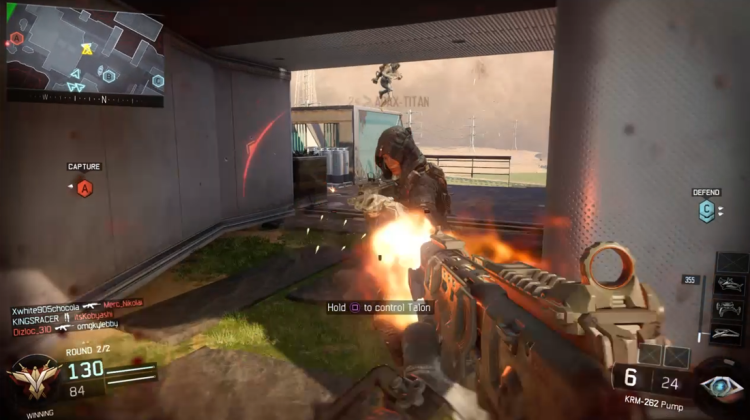Starting today, publisher Activision is kicking off the finals for the first stage of its Call of Duty World League competition, and the company has a new feature for Call of Duty: Black Ops III on PlayStation 4 to get more people watching.
In early March, Activision and developer Treyarch launched the live-event viewer inside the PS4 version of sci-fi military shooter Black Ops III. This feature enables fans to tune into major livestreams as they are happening without having to leave the game. A notification on the main menu alerts players that an event is happening, and then those gamers can check out the content without having to boot up another device. Treyarch told GamesBeat that it thinks this is a great way to reach people who love these games but have maybe never really thought about watching esports before. Call of Duty is already one of the most successful games in the $99.3 billion gaming industry, but Activision wants to keep its dedicated customers engaged with a thriving competitive scene.
But the publisher doesn’t just want to do this for Call of Duty. In January, Activision acquired esports organizer Major League Gaming (MLG) to help it build the “ESPN of esports.” And that will manifest as Activision using MLG’s assets to build up events for the games it owns.
“There’s a tremendous amount of excitement for esports at Activision,” Mike Sepso, senior vice president of media networks for Activision, told GamesBeat. “I think that was illustrated by the acquisition of MLG.”
For the love of the esports game
Another example of the excitement is the live-event viewer. It took Treyarch and MLG just a three weeks of work to combine their technologies and put broadcasts inside of Black Ops III. Typically, a new feature like this doesn’t go into a major triple-A game at that speed unless everyone involved is sure about it. But Treyarch has always felt sure about esports.
“The viewer comes off a long string of features that Treyarch developed with a core philosophy to bring as much content to our fans as we can,” Black Ops III game director Dan Bunting said. “Not just content that we create, but content that comes from the community and that it embraces as its own.”
Among the three Call of Duty studios (Treyarch, Infinity Ward, and Sledgehammer), Treyarch has has done the most to embolden its community of content creators and esports players. That started with Black Ops I’s theater feature, which enabled gamers to create and share clips of their multiplayer action. That gave the best players an easy way to share their tips and tricks and to start building an audience, which is crucial to esports players.
“It’s really a part of our motivation to build as much interest at a grassroots level for competitive Call of Duty esports,” said Bunting. “We started learning about competitive gaming with Black Ops I. That was the first project where we tried to understand it and incorporate it into our own methodologies.”
Bunting explained that they continued along that path with the League Play feature in Black Ops II that enabled players to compete in ranked seasons.
“We’ve carried that forward with Black Ops III, and now you see how Activision has the Call of Duty World League flourishing,” he said.
Powers combined
Because Treyarch has always cared about esports, it knew it wanted to bring live video of Call of Duty World League directly into the game.
“We had already been working on streaming-video tech,” Treyarch technology director Martin Donlon told GamesBeat. “We actually have a long history with streaming ever since Black Ops I, and the uploads we did with the theater files. With Black Ops II, we had online streaming. That’s something all the consoles do now, so we feel like we were a little ahead of the curve by offering as part of the game itself. We had been dabbling over the last three games.”
So Treyarch was working on the tech to present video in the game, and when the MLG acquisition happened everything else fell into place.
“The relationship with MLG really enabled us to collaborate,” said Donlon. “We could work with their engineering team and they could work with ours. After that, we got the streaming tech working together after, literally, two or three weeks worth of work.”
Sepso, who cofounded MLG before moving onto Activision, says that most people underestimate the tech the company had built up.
“I think MLG has always really been known for running and administrating leagues and throwing really great esports events across the U.S. but less known for what the product and engineering teams built,” he said. “There’s the broadcasting system, which is really a premium, high-end broadcast network that was meant to be for a few highly produced broadcasters rather than a user-generated content platform. And we’re taking it back to that. And working with Treyarch on bringing that experience right into the game has been kind of one of the first things we wanted to jump in with.”
One of the big things that helped is that MLG had always built its tech to work with apps and on mobile and not just browsers. That made it easy to integrate into Call of Duty: Black Ops III, which is essentially an app itself.
Now, that Treyarch has this tech in place, it can focus on delivering CWL events over the weekend and then throughout the year.
“We’re really excited for the CWL coming up on the weekend,” Treyarch studio design director David Vonderhaar told GamesBeat. “We still have a whole other back half to go. The level of effort we put into esports is a big deal here. It’s ongoing. No one has gone on vacation on our esports initiative.”
VentureBeat's mission is to be a digital town square for technical decision-makers to gain knowledge about transformative enterprise technology and transact. Learn More

